The Recollections of Jane Freeman (Part 2)
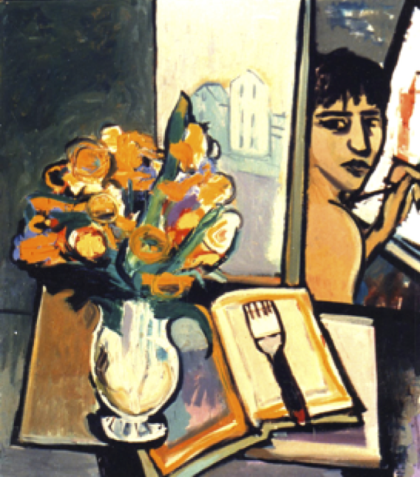 When artist Jane Freeman mentioned—in a comment on John Willenbecher’s post about Tribeca’s pioneer days—that she had some photos from back then, I emailed her to see if she’d let me run them. She was about to get a puppy, so we agreed that she’d have her hands full for a while. “I’ve also written essays, rather as John has done, about early Tribeca and how wonderfully strange everything once was,” she added. And now she’s sharing them with us. I find them marvelously evocative, and it’s the kind of writing that this site—being mainly engaged with news—rarely showcases. Note that they’re not necessarily in chronological order, and this is part two. (Part 1 is here.) The art is all by Jane.
When artist Jane Freeman mentioned—in a comment on John Willenbecher’s post about Tribeca’s pioneer days—that she had some photos from back then, I emailed her to see if she’d let me run them. She was about to get a puppy, so we agreed that she’d have her hands full for a while. “I’ve also written essays, rather as John has done, about early Tribeca and how wonderfully strange everything once was,” she added. And now she’s sharing them with us. I find them marvelously evocative, and it’s the kind of writing that this site—being mainly engaged with news—rarely showcases. Note that they’re not necessarily in chronological order, and this is part two. (Part 1 is here.) The art is all by Jane.
••••••••••••••••••••••
Maybe Mercury is in retrograde, and accounts for a rash of bad manners from strangers that I’ve encountered recently. Maybe it’s New York. Of course I don’t blame planets or the city. I’ve learned to examine what part I might play in adversarial situations, for it usually does take two to tangle. But not always. In the cases described below, which happened over a span of two days, I chose to bow out rather than engage. The first incident happened when the dogs and I went to Battery Park. Castle Clinton, the early 18th century fort at the tip of Manhattan, was open to visitors. I ventured in, heading for the exit just opposite. A gigantic guard appeared, and bellowed robotically, like a siren in a gun-tower: “Dogs-are-not-allowed-here! Leave-the-premises-at-once!” That’s clearly where we were headed, but he kept it up: “This-is-Federal-Property!! You-can’t-be-here! Leave-immediately!” The dogs had their tails between their legs, and I felt like a trespassing scoundrel.
Half an hour later we got to our street, which was still being ripped up from end to end. No matter: a photo shoot was spread out right in front of my door. I stepped around the sweating stylist, two ethereal models, and a model Boston terrier getting treats to stay seated. During the 15 seconds it took to fish my keys out, I observed the fascinating rows of fabric-tightening pins and clamps at the back of each girl from ankle to nape. In the five seconds it took to shove the key in and turn it, the stylist sneered, “Are you able now to move out of the shot?” The photographers had yet to take aim, so what was the hurry? Besides, I thought, I live here. How is it that irrational sociopaths and jumpy power-mongers can make me feel like the world’s most undesirable interloping scoundrel? Tails between legs once again, the dogs and I got ourselves upstairs.
Next day, on the way to Housing Works, the used-book store, I stopped for a take-out coffee. A man whined, “There’s no Half and Half!” Sure enough, there was everything but Half and Half: Skim, Whole, 2%, Soy. Trying to be helpful, I said, “Just ask them, and they’ll bring it out.” The man snapped, “Don’t tell me what to do!” My cue to be off.
At the bookstore, I headed for Art & Architecture. The section was inaccessible because someone had commandeered it. He was squatting in front of the shelves, knees apart, arms extended in a roadblock. He wasn’t just balancing his squat. I hovered expectantly, hoping he’d emerge from his reverie and move aside. But this squatting, brachiating guy read each title, left arm along the rows, right hand fingering each spine in a proprietary caress. Beneath his armpit was a book on Sir John Soane that I wanted to see. I hinted: “Excuse me?” Coldly he turned his head and said: “I’m here now. I’ve got this section. It’s mine. Go somewhere else.” I said, “But this is a bookstore.” He snapped, “At least have the courtesy to move somewhere else until I am finished!” I gave up on Art & Architecture and went to Poetry & Philosophy. As I paid for my finds, I told the clerk about the creepy man. He said, “Imagine what his life must be like.” “Yeah,” I replied. But I couldn’t.
••••••••••••••••••••••
 Through the peep-window in the front door I see a square of pines like a Christmas card. There’s a thick phalanx of Christmas trees stacked all the way down the block, some encroaching against our building and, in an adjacent “neck of the woods,” plenty more hemmed in behind the fence of the sidewalk café. This temporary forestation is both sweet and nettlesome, beautiful and unseemly.
Through the peep-window in the front door I see a square of pines like a Christmas card. There’s a thick phalanx of Christmas trees stacked all the way down the block, some encroaching against our building and, in an adjacent “neck of the woods,” plenty more hemmed in behind the fence of the sidewalk café. This temporary forestation is both sweet and nettlesome, beautiful and unseemly.
The nettlesome part is that it’s hard to get in and out of the house or down the block because of all the trees and people shopping for them and the commotion of a 24-hour presence of tree-sellers, who have brought the trees from Canada. They work in shifts around the clock and appear to sleep in their van. The unseemly part stems from my awareness that these beautiful trees are already dead. They’ve been usurped from the earth to be bought, bedizened, and dumped. I never liked the idea of hacking down vital trees to indulge brief human caprice. I wish people cultivated live trees to festoon at Christmastime.
There are many transient tree farms all around the city in this season. A few weeks ago, the traffic triangle on Sixth Avenue near Spring St. was dominated by a large tent full of Christmas lights and ornaments, boxes of tinsel, etc., and guarded by a great blow-up Santa who jumped about as Christmas music blared scratchily from an undisclosed source. The cut trees, most bundled in nylon netting, were manned by a burly guy in his forties who looked, appropriately, like a lumberjack. As I walked through the lot, he petted the dogs. Loquacious and country-friendly, he extended his hand and introduced himself as Billy. I noticed that his labial-nasal creases sparkled with wreath glitter. Billy identified all the different tree types and had me feel the Douglas firs for their suppleness. Since I’d never felt any needles before, supple or otherwise, I didn’t know how to appraise his commodity. He confided that his trees had a bigger-than-usual “gift base.” I guess I looked blank, so he explained that the more trunk exposed at the bottom, the more gifts could be piled there. I could see that more was definitely better.
Curious about why people do what they do, I asked about his background. Turned out he had a Masters in cellular biology. Even more interesting, he’d spent many years working on large cruise ships. This I wanted to know about. He gave it serious thought, then with a conclusive nod, said slowly: “Being aboard cruise ships means a lot of heavy-duty introspection time.”
It is Christmas Eve. The landscape is quite empty; its colors are orchestral: henna-brown, a touch of brass, ample silver, ivory, ebony. Faint clouds smudge the oyster-pearly sky, like fingerprints. The north meadow is spread with tarps to protect it from frost. The tarps resemble sails drying out on a pier. They’re a luminous sea-glass gray and luff ominously, mimicking in color and movement the Hudson beyond. Earlier, the tarps were dotted with hundreds of seagulls, skating to a muted duet of mournful foghorn and train whistle. And then the keening birds rose in unison, their whelken whiteness merging with the oyster sky.
Each branch and twig stands out in folk-art clarity, painted with a tiny brush. In one tree clings a passel of sparrows like remnant brown leaves. At the tree’s roots grumbles a flock of puffed pigeons. Some Canada geese bask on the lawn like a fleet of freighters. There are a few Arctic geese, too. The koi in the pond are beneath a plywood shelter topped with stones, where they’ll stay hidden ’til spring.
My mind is still on Moby-Dick. This week I built two miniatures of the Spouter Inn. One is the rain-damp façade, after this passage:
Moving on, I at last came to a dim sort of out-hanging light not far from the docks, and heard a forlorn creaking in the air; and looking up, saw a swinging sign over the door with a white painting upon it, faintly representing a tall straight jet of misty spray, and these words underneath —”The Spouter-Inn: —Peter Coffin.”
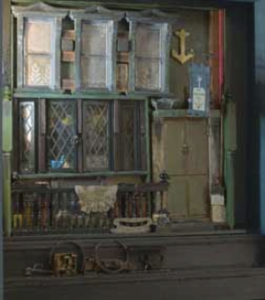 The other miniature is a construction of the room at the Spouter Inn where Ishmael and Queequeg stayed, before setting sail from New Bedford, on Christmas Day.
The other miniature is a construction of the room at the Spouter Inn where Ishmael and Queequeg stayed, before setting sail from New Bedford, on Christmas Day.
Tribeca’s first bookstore (not counting Ruby’s on Chamber Street, from long ago) has just opened. My first purchase was a pop-up Moby-Dick by Sam Ita. As I was examining the real rope rigging in the book, I glanced up to the undulant mural of literary giants over the café. Next to Whitman, Melville sits close to a pipe-smoking Queequeg. A fictitious character may not be an author, per se, but Queequeg did copy out his glyphic tattoos on his coffin. Was this act the creation of a new literary genre, i.e., autonecrology? In any case, I hope he’s enjoying his Starbucks, for tomorrow he and Ishmael set sail.
On holidays, Tribeca is quieter than a small town. In the rare absence of traffic, the dogs and I freely gallop across the West Side Highway. There’s no snow; still the white denseness of the sky is suggestive of snow; it resembles, as well, a sweeping chunk of unpolished marble. And with the river trembling like crushed gray tissue, the sight—quite a gift this Christmas morning—reminds me of an immense, hoary whale.
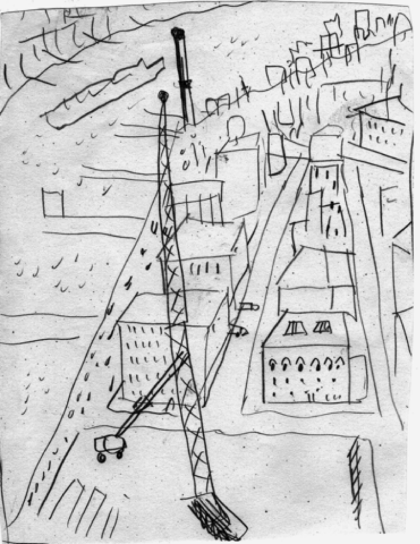 Bordered by iron fences and lath bulwarks, the lawns by the river are “closed for the winter,” bedded under tarps. The children’s garden, where in August bloom sunflowers tall as lighthouses, resembles, with its neglected plots and weathered planters, a blasted heath. The colors of the vegetal remains span the spectrum of boiled green, but amid escarole and chard, there spouts a stand of plumy grass, pale blond in the wan light, whose tawny feathered scrolls nod above a tangled skein of straw stalks.
Bordered by iron fences and lath bulwarks, the lawns by the river are “closed for the winter,” bedded under tarps. The children’s garden, where in August bloom sunflowers tall as lighthouses, resembles, with its neglected plots and weathered planters, a blasted heath. The colors of the vegetal remains span the spectrum of boiled green, but amid escarole and chard, there spouts a stand of plumy grass, pale blond in the wan light, whose tawny feathered scrolls nod above a tangled skein of straw stalks.
Near the North Cove, construction has stopped on a high rise which, conforming to the curve of the land, resembles the hull of a ship being built, complete with looped lanyards, halyards, rigging and poles projecting upward like bowsprits. Webbed nets waft in the wintry breeze; bundled tarps mimic furled sails. A hoist-hook resembles a dangling anchor. Atop the heap is a cabin-like edifice that resembles a deckhouse. Above it all whips an American flag, like a ship’s pennant. This structure seems on the brink of casting off and sailing through the harbor to the high seas.
This nautical imagery comes from reading Moby-Dick, curled in my narrow, listing bunk-bed, in an unheated little cabinet-room, with struts athwart the ceiling, in the fo’c’s’le of a house on Harrison close to the water, which was probably a mariners’ rooming house when Moby-Dick was written. To keep warm, there are the dogs and cats, and Ishmael’s advice, from his bed at the Spouter-Inn, Chapter 11:
…to enjoy bodily warmth, some small part of you must be cold, for there is no quality in this world that is not what it is merely by contrast. Nothing exists in itself…. if, like Queequeg and me in the bed, the tip of your nose or the crown of your head be slightly chilled, why then, indeed, in the general consciousness you feel most delightfully and unmistakably warm. For this reason a sleeping apartment should never be furnished with a fire…. For the height of this sort of deliciousness is to have nothing but the blanket between you and your snugness and the cold of the outer air. Then there you lie like the one warm spark in the heart of an arctic crystal.
••••••••••••••••••••••
Tribeca, on Wednesday and Saturday mornings, despite the cold, stalwart farmers arrive on Greenwich Street to sell their produce. On Saturdays, when the neighborhood quiets down, Tribeca resembles a country village, a felicity enhanced by these most welcome farmers. Shirley Bianco drives down from her farm in Bedford, N.Y. In minutes she sets up a white tent whose walls form dozens of skeins of beautiful wool, sheared from her own sheep and hand-dyed. Enclosed on three sides by thick, colorful loops of wool, it’s like I’m inside a rainbow.
Shirley’s passion is protecting the environment. She lives the opulent frugality of a latter-day Thoreau. The first time I talked with her, I was inspired to take up knitting again. I bought a pair of bamboo needles and a skein of fern-green wool. The best-smelling, best-textured wool ever. I’ve re-discovered how akin knitting is to meditation. Focusing on the needles and the yarn, you can get a knitter’s detached high.
Today, the temperature is below freezing. To warm up, Shirley sits in her car with the heat on. My dogs Caleb and Tracy and I join her for a few minutes. Then I go home to fetch some of the soup I’ve just made—winter squash, root vegetables, red lentils, quinoa, star anise. We talk about the dogs, who are Shetland Sheepdogs. Shirley invites them to Bedford to herd her 55 sheep. It’s now mid-afternoon, and Shirley disassembles the tent and packs up the station wagon. The sun already has begun to withdraw, but it’s the absence of the woolly rainbow around her booth that quickens the dark cold.
Lately it seems everyone I know is suffering from one plague or another. I’ve heard reports of mice and fleas in apartments, rats in basements, termites in the timber of weekend houses. My neighbor across the street, who boards dogs, has had a sudden infestation of fleas. Another neighbor, who found a nice-looking blanket in the trash, now has bedbugs. Despite my animals, I haven’t any fleas or ticks, thank God, though gnats swarm around the cat dish if left out too long; and huge flies buzz through the screenless windows to bang against the walls; and the ever-present drosophila scarf up scraps of onion skins and yam-ends. The moths must be having a field day in my sweaters. But no bedbugs, so far; my futon-on-plank must be too austere for bugs who like beds. And I’m pleased to announce that I’ve been mouse-free for five years now, ever since the arrival of Izzy and Poe. In the B.C. [Before Cat] era, I often felt furry-scurries across my pillow in the dark. Switching on the light and seeing the tiny things, I’d scream “eek!” as in those Saturday-morning cartoons whose plot involved an eeking, shrieking girl who, to escape a rodent, leaps onto a piano with a discordant crash. Contemptible behavior, but I did it too, minus the piano. Whenever I happened to surprise the mice by going to the bathroom in the wee hours, I’d catch them cozily tucked into my shoes, like a family of Stuart Littles.
So no mice, rats, bedbugs, or fleas, but I do have one unwelcome nocturnal visitor. A mosquito. I think it’s the same individual every night: an elusive, persistent, one-bug pestilence. It waits until I doze off to bite. Sometimes its whining whirr—like a microscopic vacuum cleaner or helicopter—wakes me, but before I can get the light on, I’m jabbed. Last night it was my right cheek. Reflexively I slapped my face, hard, and stumbled into the bathroom to assess the damage, clicking the night-light on. At three in the morning, when few of us are at our attractive best, I watched incredulously as a giant welt bloomed on my greenish visage. Of course I immediately thought of Gregor Samsa and hastily jumped back in bed. I wrapped myself up in the sheets from head to toe, hoping the bloodsucker felt sated. For the rest of the night, it seemed, I applied that juvenile remedy to allay the itch, which all Florida kids know. You inscribe an X in the welt with your thumbnail. But I’m open to other suggestions. My friend across the street, the one with the fleas, found an anti-insect lemon potion on the Internet. She recited it to me over the phone. It involves a lot of slicing and zesting, boiling pulp down into a tincture and thickening it into an ointment, etc. A lot of work for one mosquito, it seemed. Another antidote could be putting a mosquito net over the bed somehow, like they do in rainforests. The bugs will leave when it turns cold. If it ever does. A few minutes ago, as I walked sweatily down Hudson Street swatting at no-see-ums and scratching at my cheek, I overheard a young woman wail into her cellphone: “I came here for the fall foliage. I never dreamed it would be eighty thousand degrees in October.” Yeah, eighty thousand degrees and still buggy.
••••••••••••••••••••••
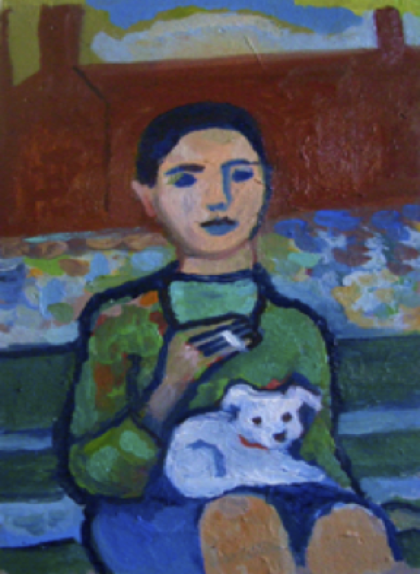 Yesterday was the Tribeca Film Festival street fair, an occasion that affords an annual opportunity to leave this neighborhood for some destination northward, southward, or eastward. By last night, a covey of white tents and several bandstands had been set up. The unrelated bandstands, one of which was directly beneath my window, were set to broadcast a daylong amplification of static and stridency.
Yesterday was the Tribeca Film Festival street fair, an occasion that affords an annual opportunity to leave this neighborhood for some destination northward, southward, or eastward. By last night, a covey of white tents and several bandstands had been set up. The unrelated bandstands, one of which was directly beneath my window, were set to broadcast a daylong amplification of static and stridency.
Around 9:30, the first bridge-and-tunnelers and pram-and-nanny families drifted into Greenwich Street. Five minutes later, the dogs and I decamped. North would take us to Chelsea via the river esplanade. East would take us to Tompkins Square Park, which has a great dog run (large, round, and the ground cover is cedar chips). But the most tranquil route was to head south, to the Battery.
I packed picnic lunches for the dogs and me. Also some reading, writing and drawing supplies. I brought The Adventures of Frog and Toad, and a random collection of peregrination essays: Rousseau’s Reverie of the Solitary Walker, Hesse’s Wandering, Max Beerbohm’s “Going Out for a Walk,” R.L. Stevenson’s “Walking Tours,” etc.; and a brief history of the flâneur, to complement the nomadic condition. Also in my backpack were a dog comb with long and short tines, and a summer hat for when the 53-degree morning chill rose to 70. When it did, as Accuweather predicted, I traded the teal watch-cap for a pink bateau.
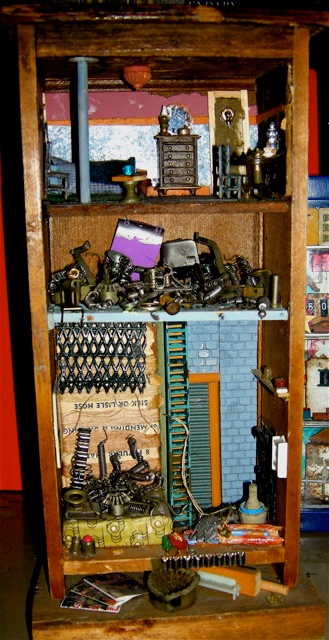 We sat on the lawn at Battery Park. As I ambled through my ramble-essays, I harvested enough of Caleb’s undercoat to fill a trash bin. The more I combed, the more soft white fluff came out. Tracy wasn’t shedding as much, but was content to watch. When we weren’t sitting, we kept on the move, sometimes perching on a park bench or on some dandelion-dotted grass. Once a homeless person with a cart of brimming gallimaufry approached, and began to confide in the dogs. Tourists drifted by, crooning: Ohhh! I miss my dog! / Are those miniature collies? They’re so cute! /I grew up with shelties! / Can I pet them?
We sat on the lawn at Battery Park. As I ambled through my ramble-essays, I harvested enough of Caleb’s undercoat to fill a trash bin. The more I combed, the more soft white fluff came out. Tracy wasn’t shedding as much, but was content to watch. When we weren’t sitting, we kept on the move, sometimes perching on a park bench or on some dandelion-dotted grass. Once a homeless person with a cart of brimming gallimaufry approached, and began to confide in the dogs. Tourists drifted by, crooning: Ohhh! I miss my dog! / Are those miniature collies? They’re so cute! /I grew up with shelties! / Can I pet them?
We spent eight consecutive hours in plein air, a record for me. Around 5:30 we headed back, all of us transformed. Without his undercoat, Caleb was half his original size. Tracy seemed more confident. And gosh-golly-gee, I had survived a whole day without the Internet.
In Tribeca, the bandstands were playing their clashing final sets. The street was littered with paper plates, balloons, and remnant crowds. We went upstairs.
Oxygen-drunk, we retired early. I was lulled by the hollow-metal clangs of tents being disassembled, sailcloth whooshing to the paving stones and macadam—the thuds and bumps of set-striking. Those sounds reminded me of my first nights on Harrison Street, when I was awakened in the wee hours by cheese barrels thudding into the trucks at the loading docks below. That was 35 years ago, when Tribeca was empty, industrial, ignored, and very interesting.
Update: Comments have been turned off due to spam. To have them turned back on, email tribecacitizen@gmail.com.







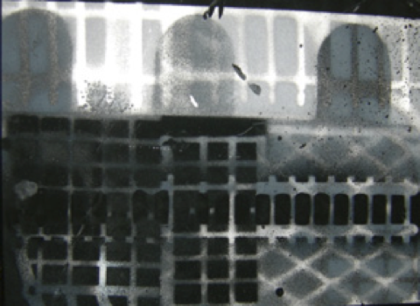
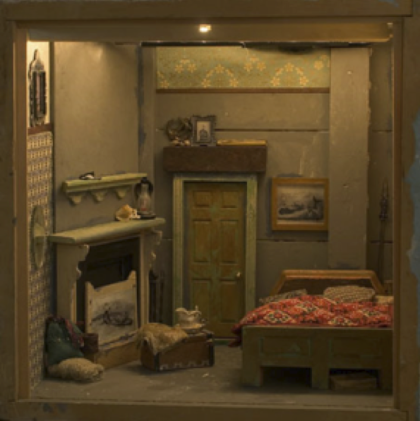
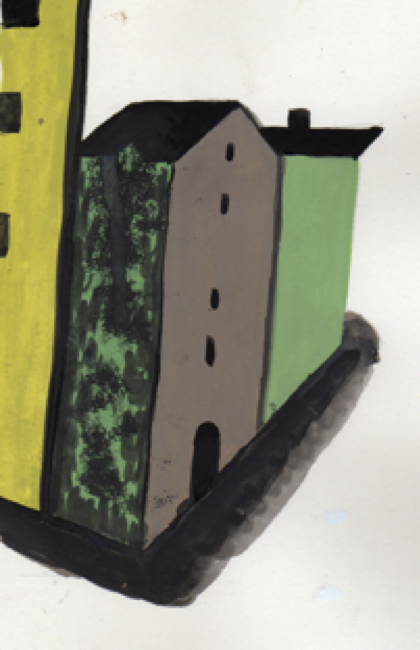







How beautifully written and painted, I didn’t want it to end! I hope you’ll give us a few more peeks soon. Thanks so much Jane!
Thanks again Jane. Such a pleasure to read and to see your work.